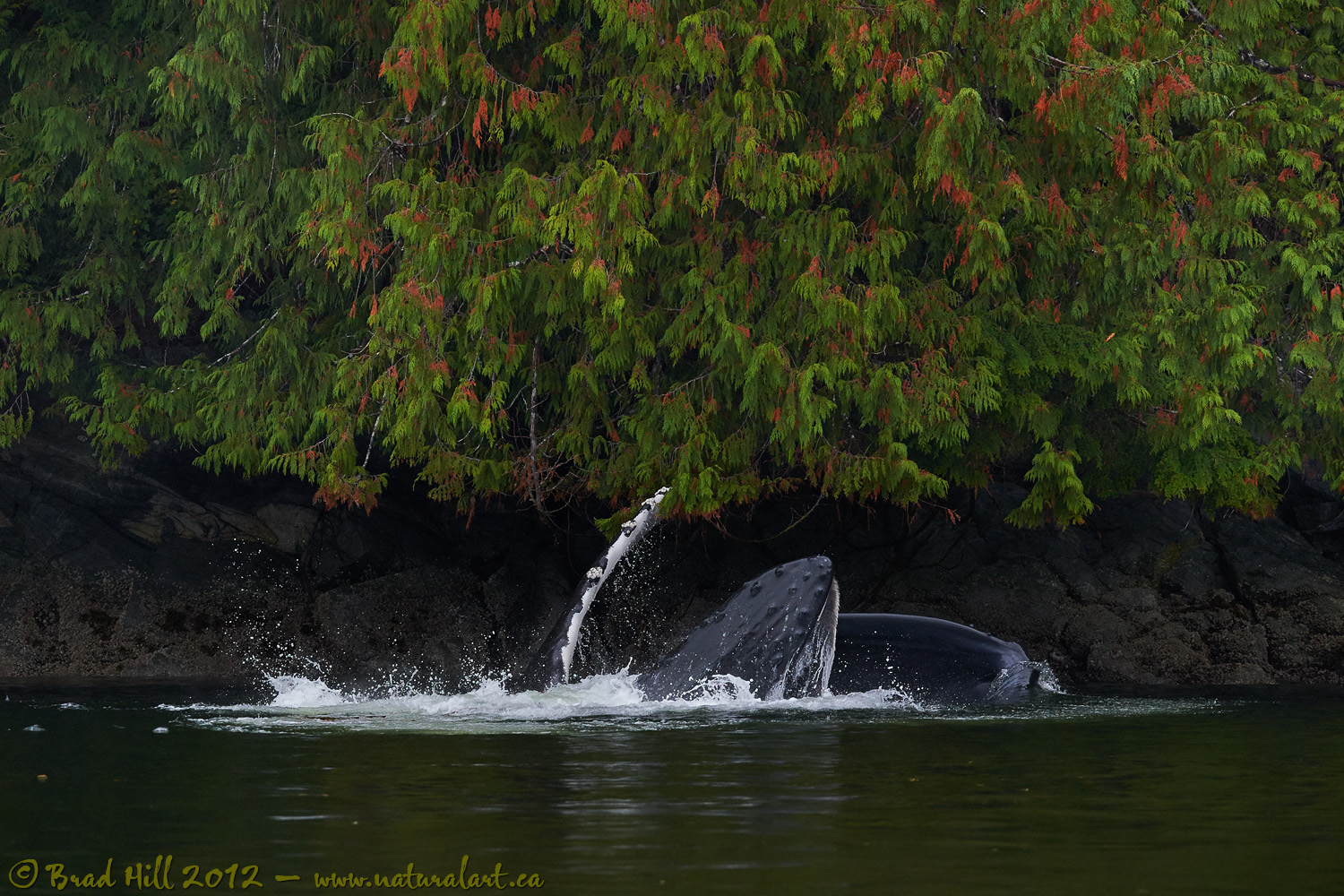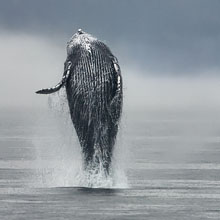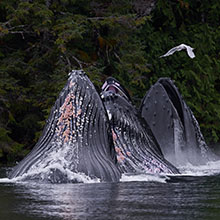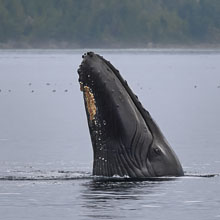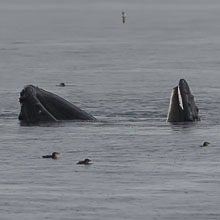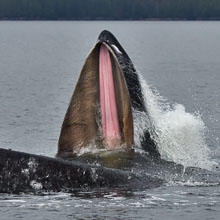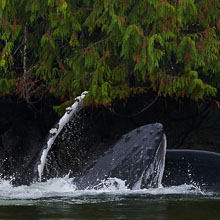Availability: Undetermined - Enquiries?
In the Field
Hedge Trimming, Humpback Style. Great Bear Rainforest (central BC coast), BC, Canada. September 29, 2012.
Most folks who have spent time in heavily forested coastal regions will have noticed how the trees (and their boughs) all grow down to a very uniform distance from the waterline...as shown above. Most who have thought about it probably assume that this straight line of vegetation growth above the shoreline is related to the high-tide line. Well...here's an alternate theory: humpbacks trim the "hedges" back with their pectoral fins! After all, seeing is believing - right? ;-)
This shot is of a humpback whale feeding via bubble-netting - you can see the faint outline of the circular bubble-net on the surface of the water. Because most folks don't see humpbacks on a daily basis it can be a little hard to figure out exactly what body parts you're looking at. So...the large "bucket" on the right side of the image (where the water is draining into) is the whale's lower jaw, the wedge-shaped and "bump" covered section is the whale's upper jaw (complete with baleen plates), and the nearly vertical thin white thing is the whales pectoral fin (you should be able to see barnacles on it on the large version of the image). This particular whale was bubble-netting alone right along the shoreline - so close that some of the bubbles actually came up right on the rock wall in the background.
The tricky thing about capturing this shot was getting the exposure right. The scene was very dark - the skies were heavily overcast, the water was very dark, and the whale black. Many photographers - including some pretty experienced ones - instantly react to a scene like this by thinking they need to over-expose the shot (compared to what their camera's light meter is suggesting to them). Well...if you're like the majority of photographers and are using some form of multi-segment metering system (like Canon's evaluative metering and Nikon's matrix metering) this would be the exact WRONG thing to do. Your camera's light meter is always suggesting an exposure that pushes scenes toward neutral grey. So if your goal is to record scenes as they were seen in the field (and you're using multi-segment metering), you must under-expose scenes that are darker than neutral gray, and over-expose scenes that are brighter than neutral gray. In this case if one used the exposure their light metering was suggesting, those bits of white on the pectoral fins and the white in the splashing water would have been totally blown out (over-exposed). The situation would have been worse if one over-rode the exposure and over-exposed the scene. To get this exposure "right" I had to under-expose the scene (compared to the matrix-metered "suggestion") by 1.67 stops!
The take home lessons? First...whales like well-trimmed hedges! Second...the world's simplest exposure bible: under-expose dark scenes; over-expose bright scenes! And experience and practice will teach you how much you should under- or over-expose each individual scene.
The detail in this image is better appreciated in a higher resolution form - so here's a 2400 pixel version of it:
• Hedge Trimming, Humpback Style: Download 2400 pixel image (JPEG: 1.7 MB)
ADDITIONAL NOTES:
NOTE 1: This image - in all resolutions - is protected by copyright. I'm fine with personal uses of it (including use as desktop backgrounds or screensavers on your own computer), but unauthorized commercial use of the image is prohibited by law. Thanks in advance for respecting my copyright!
NOTE 2: Like all wildlife photographs on this website, this image was captured following the strict ethical guidelines described in The Wildlife FIRST! Principles of Photographer Conduct. I encourage all wildlife photographers to always put the welfare of their subjects above the value of their photographs.
NOTE 3: This image was captured during one of my "Into the Great Bear Rainforest" photo tours in the autumn of 2014. Each year I offer trips into two different parts of the Great Bear Rainforest as well as one to photograph aquatic mammals and oceanscapes near the northern tip of Vancouver Island. And, in selected years, I also offer photo tours to locations to capture other highly sought-after subjects, such as various owl species of the boreal forest and wildlife of Canada's Arctic. Details about these trips can be found on the Photo Tours page of this website.
Behind the Camera
Hedge Trimming, Humpback Style. Great Bear Rainforest (central BC coast), BC, Canada. September 29, 2012.
Digital Capture; RAW 14-bit format; ISO 1800.
Nikon D4 paired with Nikkor 400mm f2.8 VRII lens. Hand-held. VR on and set to "normal" mode.
1/1250s @ f4.5; -1.67 stop compensation from matrix-metered exposure setting.
At the Computer
Hedge Trimming, Humpback Style. Great Bear Rainforest (central BC coast), BC, Canada. September 29, 2012.
RAW Conversion to 16-bit TIFF, including first-pass/capture sharpening using Capture One Pro Version 7. Three raw variants (processed from raw) differing by a total of 1 stops in exposure.
Further digital corrections on resulting 16-bit TIFF files using Adobe's Photoshop CS6 and Light Craft's Lightzone. Photoshop adjustments including compositing the raw conversion exposure variants, selective tweaks to exposure (using adjustment layers), and selective sharpening for web output. Final tone tweaking performed using tonemapper/re-light tool in Lightzone.
Conservation
Hedge Trimming, Humpback Style. Great Bear Rainforest (central BC coast), BC, Canada. September 29, 2012.
Ten percent of the revenue generated by this image will be donated to Raincoast*.
Species Status in Canada*: Threatened - North Pacific population (May 2003).
Humpback Whales (Megaptera novaeagnliae) are active, acrobatic whales that can throw themselves completely clear of the water (a behaviour known as breaching) and will swim on their backs with both flippers in the air. Humpbacks are large (up to 14m - or 46 feet - in length and 40 tonnes in weight) and with huge flippers.
Humpbacks are found in tropical, temperate, and sub-polar waters around the world. They are found on both the east and west coasts of North America. The North Pacific population has been estimated at between 6,000 and 8,000 individuals, but only a few hundred of these are found in the waters off the coast of British Columbia.
While Humpbacks are recovering from the damage done to their populations by commercial fishing, the are still subject to a variety of threats from human activities, including becoming entangled in fishing nets, noise and chemical pollution and habitat destruction.
*The Raincoast Conservation Society (and Foundation) is an effective and efficient organization that has been fighting for protection of this unique habitat. If you are looking for a meaningful way to contribute to the conservation of this amazing ecosystem, Raincoast will provide maximal "bang" for your conservation dollars.
**as determined by COSEWIC: The Committee on the Status of Endangered Wildlife in Canada












